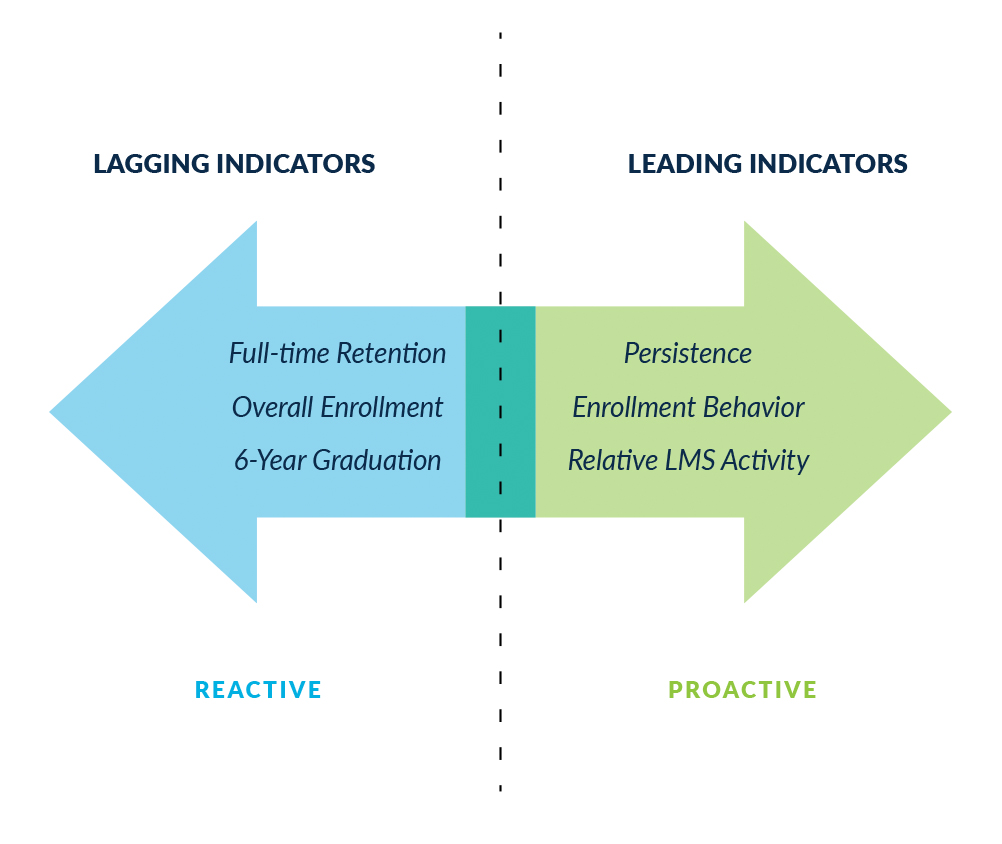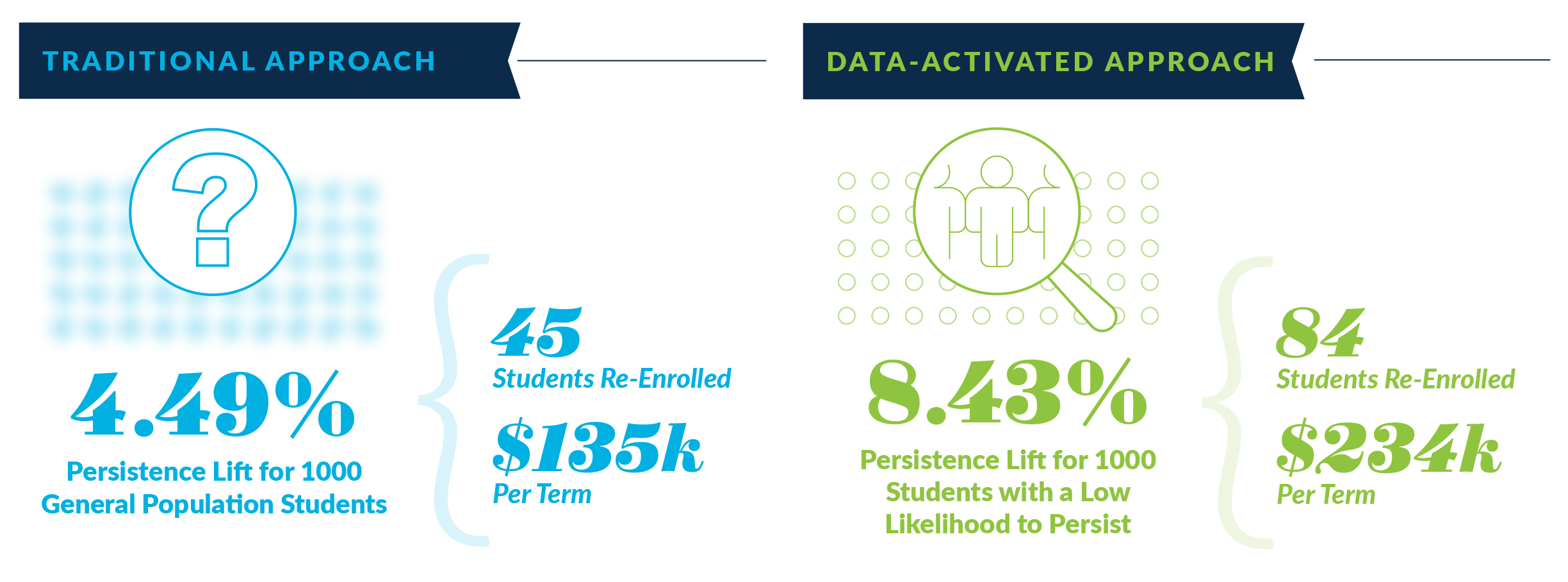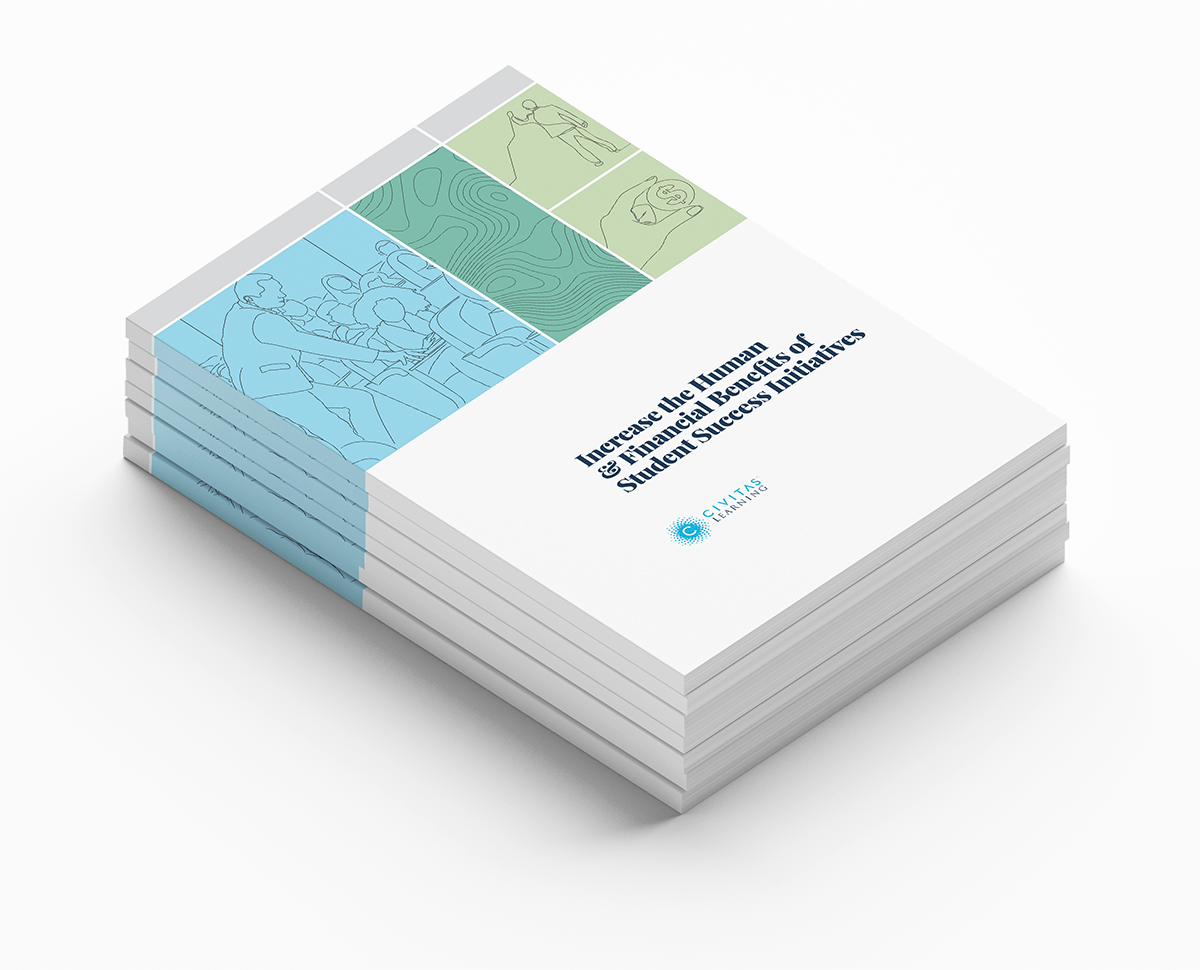Increase the Human & Financial Benefits of Student Success Initiatives
After decades of growth and expansion, colleges and universities now face massive disruption to their traditional way of doing business. This challenges conventional operating models, results in lost tuition revenue, and even threatens the very existence of many institutions.
The critical work of decreasing costs while wisely investing in student success demands precise and strategic resource allocation. Alongside traditional fiscal practices like sunsetting unpopular academic programs, increasing tuition, and raising funds through development, you must also understand the return on investment of your student success initiatives (SSIs). Regular evaluation of student success practices provides the specific insight needed to make informed decisions and take action to incrementally improve student outcomes and generate more revenue over time.
Shifting your thinking about student success initiatives from a spending mindset, “What’s the cost?” to an investment mindset, “What return will result from investment in this program?” leads to more pragmatic decision-making and financially healthy institutions. This approach also enables you to adjust, pivot, and reallocate energy, effort, and funds to the right combination of initiatives that will most significantly improve student success.
What’s in the Guide:
- Four essential practices to an ROI-generating student success strategy
- Examples of ROI generating practices from Civitas Learning partner institutions
- Step-by-step guidance on calculating the impact of your SSIs on student and financial goals
How to Shift to an ROI-Generating Student Success Strategy
1
Use Persistence as a Student Success Leading Indicator
Evaluating how student success initiatives (SSIs) affect persistence across individual students and student groups allows you to immediately understand which programs impact outcomes and which don’t. Persistence provides teams with a leading indicator of success needed to inform actions with enough time to change future results. Assessing a program’s influence on persistence enables you to understand how an initiative contributes to re-enrollment and generates net tuition revenue each term.
Without persistence, other metrics don’t provide adequate insight into how SSIs positively impact outcomes. Events beyond your institution’s control, such as the COVID-19 pandemic or a fluctuating labor market, often impact enrollment numbers. Retention is a poor indicator of an institution’s overall health because it only represents a fraction of your student population. And 6-year graduation is a lagging indicator that may be easy to measure but challenging to change.
Many SSI evaluation approaches don’t control for selection bias. Results are produced with mismatched comparison groups and show correlation rather than causation. While important context, this approach doesn’t help leaders understand what initiatives are directly improving their students’ success. Often based on lagging indicators, this information doesn’t provide real-time, actionable insights that enable you to act more immediately to improve student outcomes. Looking at a program’s impact on persistence allows you to pinpoint if and how your initiatives contribute directly to re-enrollment each term.
Understanding how SSIs help students persist toward graduation provides you with the critical information you need to make strategic decisions. Identifying impactful SSIs allows you to intentionally connect students to relevant programs and adjust the approach to ensure every practice contributes to your institution’s financial health by generating net tuition dollars.
The Value of Persistence

Figure 1: Leading indicators like persistence allow you to gain more timely insights into which programs are successful and which students need help.
“Just In Time” Advising Campaign Yields $150k ROI at Utah State University
One public Utah university saw that many at-risk students were also the least likely to persist and the least likely to respond to general outreach. Rather than waiting for students to seek help during open registration, advisors use predictive analytics to prioritize outreach at critical moments throughout the term. Using
persistence likelihood within the Civitas Learning Platform advisors prioritize outreach to students with the lowest likelihood of persistence. Segmenting data reveals that advisors can most significantly impact students with a medium to high probability to persist.
By clearly understanding the impact of advising practices on specific student groups, success teams increased student engagement among medium to high-risk students by 67% with existing staff, lifted persistence by 1.9 percentage points by tailoring efforts to student needs, and generated a $150k return on investment. Knowing how specific outreach tactics impacted the persistence of particular student groups enabled university leaders to work together to provide their advising teams with the resources and tools they needed to improve student outcomes.
2
Segment Data to Match Students to the Right Resources
While highly effective SSIs can improve overall outcomes, their impact is more powerful when carefully matched to specific student groups. To accurately determine and maximize the ROI of SSIs, you must move beyond average outcomes. Evaluating how particular initiatives impact persistence and completion for specific groups of students allows you to strategically promote services and scale efforts by delivering the proper support to the right student at the right time. This approach enables your advising and student success teams to act precisely to improve outcomes and ease capacity constraints strategically.
Segmenting program impact data makes it easy to see precisely which interventions work best for particular students. For example, in an analysis of 1,000 initiatives across 55 unique institutions, Civitas Learning found highly effective advising programs lift persistence by 5.80 percentage points (pp) for the general student population but raise persistence for Hispanic students by 6.96 pp and first time in college students by 7.07 pp. With insight into an initiative’s impact on specific sub-sets of students, your team can scale proactive intervention by prioritizing when and how your team connects particular student groups to relevant resources.
This level of strategic, data-informed intervention makes it possible to address capacity limitations by strategically connecting students to those programs that will best address their needs now. The ability to pinpoint which practices help your students persist toward graduation improves the effectiveness of your student success initiatives. This improvement also translates to higher persistence, more efficiency, and increased return on investment.
Maximizing Academic Support Services

Figure 2: Understanding the impact of student success initiatives on specific financially sustainable.sub-sets of students enables your team to act precisely to improve outcomes, increasing overall student persistence and tuition revenue.

Data-Activated Email Campaigns Generate $1.2M in Net Tuition Revenue at University of Central Oklahoma
The Student Advocacy team at The University of Central Oklahoma (UCO) uses precise data-activated communication campaigns directed to specific student groups instead of large-scale general outreach. This approach allows Student Advocacy to proactively connect their students to a network of collaborative student success initiatives at scale with limited staff and little additional implementation costs.
More precise communication enables UCO’s student success units to work together to create multiple touchpoints for specific vulnerable student populations. In one campaign, The Student Advocacy team increased financial literacy messaging during new student orientation to address common barriers to student financial wellbeing.
The team wove nine touchpoints on financial literacy throughout the orientation programming resulting in the highest fall-to-fall retention rate in 6 years, an increase of 3.4 percentage points. Over time, UCO continues to achieve marginal cumulative gains by using multi-pronged data-activated communication practices. Their intentional messaging campaigns have resulted in 321 students persisting who would have otherwise withdrawn, translating to $1.2 million in net tuition revenue when compounded by term. These gains make a difference in UCO students’ lives and provide the institution with funds to reinvest in student success and remain financially sustainable.
3
Cultivate a Campus-Wide Data Culture
Sustained improvement in student success requires crossfunctional teams to regularly evaluate core approaches and assumptions about what works at their particular institution. Cultivating a campus culture that takes a datainformed approach to resource allocation moves teams away from duplicating efforts and equips them to focus resources and interventions where they will have the most significant impact.
Key aspects of this approach are frequent crossfunctional communication, collaboration, and coordinated data-informed action. Successful institutions are intentional about how they work together to create a data analytics infrastructure and data-activated culture at their institutions.
Civitas Learning partners often establish several crossfunctional teams like strategic workgroups, a centralized data governance team, student engagement teams, and student success networks to make urgent decisions, evaluate progress, and take action on insights. They also invest in creating a curated and comprehensive source of knowledge that can be accessed across teams so everyone is working from the most current information and has shared context to make strategic decisions.
Creating cross-functional working groups breaks down information silos, ensures accountability, and makes sustained intervention feasible. This collaborative approach to SSI evaluation and strategic planning enables leaders to align on where to adjust programs, reallocate resources, and coordinate action to help students succeed. Together teams can better understand how SSIs work together to impact student experiences, allowing all stakeholders on campus to take data-informed, coordinated actions in their day to day work that increase the number of students who re-enroll and graduate.

Austin Community College Gains $1.36M in ROI with Data-Informed, Team-Based Approach to Student Success
Austin Community College (ACC ) formed a cross-functional team responsible for expanding continuous and real-time data analytics to build a district-wide strategy to increase student retention, persistence, and completion. This team is instrumental in creating a data-informed culture that improves student success practices across departments on all 11 ACC campuses.
A data-informed, team-based approach to student success enables ACC to make strategic decisions about how best to adjust SSIs to better serve students.
Coordinated action on insights into what works for their students includes:
- Centralizing Student Accessibility
- Aligning learning labs across the district
- Shifting from transactional advising to coaching
- And more
By establishing a collaborative data culture, ACC re-enrolled 1300 more students translating into $1.36M in ROI in just one semester.
4
Regularly Evaluate Student Success Initiative Efficacy
To find the right combination of practices, student success teams must align on what approaches work at their particular institution. With decreasing state funding and flattening resources, knowing where to invest limited funds is necessary. And leaders need a way to continuously assess every initiative’s efficacy and return on investment to adjust and strategically invest in working approaches. Knowing what works for your student allows you to create a system of SSIs that work together to improve outcomes for specific groups of students-resulting in larger cumulative gains over time.
Civitas Learning partners often share that without institution-specific analytics to provide a clear picture of students’ actual experiences, their decision-making becomes informed by dominant narratives, myths, and best guesses. Resulting, far too often, in their teams delivering interventions and support to students too late or not at all. With institution-specific analytics, they can easily see which practices improve student success and generate a return on investment. This insight into what works enables them to create initiatives and take actions tailored to meet the needs of their particular students—allowing them to remove barriers they didn’t see before and improve outcomes.
To assess the impact of a particular initiative, it’s important to determine if a program is helping students persist and achieve long-term success. To better understand the effectiveness of SSIs, leaders need the ability to quickly and efficiently run analysis across the breadth of their SSIs so they can continually measure and adjust their approach. They also need a way to control student self-selection bias to understand the effectiveness of a particular initiative more accurately.
Our partners who understand the true impact of their student success initiatives go beyond evaluating standard success metrics like changes in GPA, improvement in course grades, or student opinion. Instead, they broaden their focus to include assessing a particular practice’s impact on persistence and its ability to generate a return on investment. More accurate insight into the efficacy of SSIs provides important information needed to answer urgent questions and make difficult decisions about how best to invest in student success.

Calculating Student Success Initiative ROI
Estimate the number of students who persisted per term by multiplying the number of student users (For example, the number of students who participated in academic tutoring sessions the last term) by the overall lift in persistence (The anticipated persistence lift resulting from the initiative).
[X] student users x 3% lift in persistence =
[Y] students who persisted
Determine the program’s ROI by multiplying the number of students who persisted per term by your institution’s net tuition revenue (The average across Civitas Learning’s partner community is $3000 per term).
[Y] students who persisted x
$3000 net tuition revenue per term =
Program ROI
[X] student users x 3% lift in persistence =
[Y] students who persisted
Still Calculating?
Run the numbers on the impact of your institution’s student success initiatives using our ROI calculator.
Need Help Assessing Student Success Initiative ROI?
We’re happy to support you as you evaluate the efficacy of your student success initiatives.
Get More Return on Investment from Your Student Success Initiatives
Your student success teams are working hard to re-enroll your students and ensure they persist to
graduation. Despite increased investment in student success, you might not be seeing the results you expect. Knowing what student success initiatives work for students at your institution is essential for your financial sustainability. Understanding which practices move the needle for success and how they support the financial health of your institution empowers you to invest limited funds and people into those programs with the most impact on student outcomes.
Interested in learning more about how to invest and design student success initiatives that help students and contribute to a financially sustainable institution?
